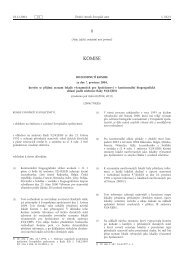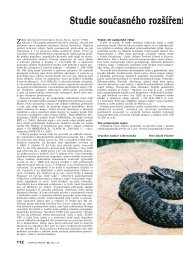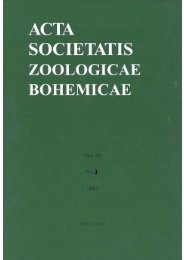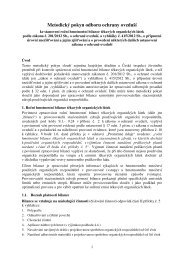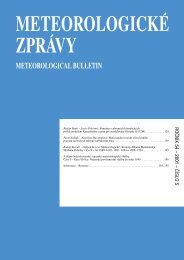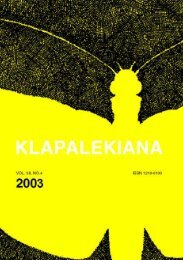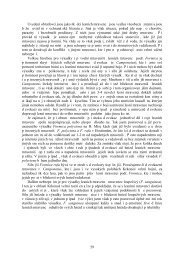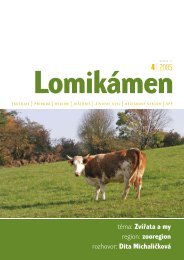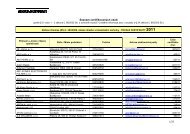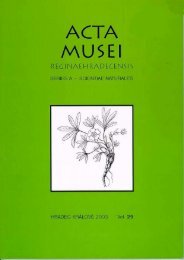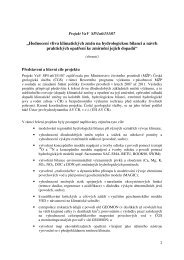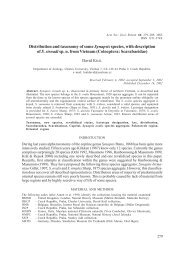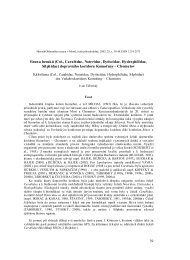journal of forest science
journal of forest science
journal of forest science
Create successful ePaper yourself
Turn your PDF publications into a flip-book with our unique Google optimized e-Paper software.
asis <strong>of</strong> browning and changes in consistency <strong>of</strong> root tissue<br />
(ig. 1).<br />
The influence <strong>of</strong> different ways <strong>of</strong> autoclaving and<br />
interval <strong>of</strong> second measurement on electrolyte leakage<br />
Next, the influence <strong>of</strong> different duration <strong>of</strong> autoclaving<br />
and second measurement on the rate <strong>of</strong> electrolyte<br />
leakage was examined. No marked difference between<br />
EL values was found. In this study, EL values slightly<br />
decreased with longer time <strong>of</strong> autoclaving and interval<br />
<strong>of</strong> second measurement. It probably means that a longer<br />
time <strong>of</strong> autoclaving is necessary for leakage <strong>of</strong> all electrolytes.<br />
On the other hand, there is in practice an applicable<br />
(fast) method to find the physiological quality <strong>of</strong><br />
planting stock: sufficient time interval <strong>of</strong> autoclaving<br />
10 min and allowing 24 h before second measurement. It<br />
is suitable to use 24 h interval <strong>of</strong> second measurement<br />
with respect to speed <strong>of</strong> the method, whereupon time for<br />
total measurement <strong>of</strong> electrolyte leakage is 48 h. Also,<br />
10 min interval <strong>of</strong> autoclaving is sufficient to destroy cell<br />
membranes and to extract <strong>of</strong> cell sap in deionized water.<br />
By using this methodology (10 min <strong>of</strong> autoclaving allowing<br />
24 h before measurement) SCHÜTE and SARVAŠ<br />
(1999) found strong correlations (r 2 = 0.97) between electrolyte<br />
leakage from tap root and later regrowth <strong>of</strong> the<br />
terminal shoot. This correlation was detected on container<br />
and bare-rooted planting stock <strong>of</strong> oak after frost<br />
(n = 15) and desiccation (n = 12) stress treatments.<br />
The same results <strong>of</strong> the influence <strong>of</strong> different length <strong>of</strong><br />
autoclaving on EL from fine roots were reported MC-<br />
KAY (1997, unpublished). On the other hand, DEANS et<br />
al. (1995) concluded that allowing 5–7 days after treatment<br />
for electrolyte leakage equilibration, followed by<br />
autoclaving 90–120 min at 121°C and allowing 24 h before<br />
measurement provides a reliable method for assessing<br />
freezing injury in small pieces <strong>of</strong> leafless stem tissues.<br />
Electrolyte leakage after stress treatment <strong>of</strong> the same<br />
intensity on different dates<br />
Changes <strong>of</strong> EL values were tested after stress factors<br />
<strong>of</strong> the same intensity, acting on different dates. The highest<br />
leakage was found for both stress factors in vegetation<br />
period. This increase in vegetation period against<br />
EL for planting stock in dormant status was about 40%<br />
after desiccation stress and about 33% after frost stress.<br />
COLEMAN et al. (1992) found that the average increase<br />
in hardiness <strong>of</strong> four subalpine conifers from August to<br />
December was 2.4 times for foliage and 1.4 times for<br />
roots. The same results are reported in several studies in<br />
which it is stated that planting stock in dormancy is hardier<br />
than during vegetation period (MEXAL, CARLSON<br />
1981; RITCHIE 1986; RITCHIE, SHULA 1984).<br />
CONCLUSION<br />
– Measurement <strong>of</strong> electrolyte leakage from tap root is<br />
rapid, precise method for finding actual physiological<br />
quality <strong>of</strong> planting stock at relatively low cost.<br />
– The rate <strong>of</strong> electrolyte leakage can be influenced not<br />
only by injury <strong>of</strong> cells but also by methodology <strong>of</strong><br />
measurement and therefore it is problematic to make<br />
a comparison <strong>of</strong> results obtained by different methods<br />
<strong>of</strong> measurement.<br />
– It is necessary to use for determining the physiological<br />
quality <strong>of</strong> planting stock the same method <strong>of</strong> measurement<br />
<strong>of</strong> electrolyte leakage for all variants.<br />
Acknowledgement<br />
This study was carried out with financial support from<br />
the Commission <strong>of</strong> the European Communities, Agriculture<br />
and isheries (aIR) specific RTD programme CT<br />
95-047: A European approach for assessing: regrowth<br />
potential <strong>of</strong> woody plants: parameters for plant vitality<br />
and dormancy <strong>of</strong> planting stock. The author thanks the<br />
Germany Academic Exchange Service for PhD. fellowship<br />
at orestry Institute in Escherode and thanks Z. Al-<br />
Attasová for her English correction <strong>of</strong> the text.<br />
References<br />
BURR K.E., TINUS R.W., WALLNER S.J., KING R.M., 1990.<br />
Comparison <strong>of</strong> three cold hardiness tests for conifer seedlings.<br />
Tree Physiol., 6: 351–369.<br />
COLEMAN M.D., THOMAS M., McNAUGHTON G., SMIT<br />
B.A., 1992. Root cold hardiness and native distribution <strong>of</strong><br />
subalpine conifers. Can. J. or. Res., 22: 932–938.<br />
COLOMBO S.J., WEBB D.P., GLERUM G., 1984. rost hardiness<br />
testing: an operational manual for use with extended<br />
greenhouse culture. orest Research Report No. 110. Ministry<br />
<strong>of</strong> Natural Resources.<br />
COLOMBO S.J., HICKIE D.., 1987. A one-day test for determining<br />
frost hardiness using the electrical conductivity<br />
technique. Ontario Tree Improvement and orest Biomass<br />
Institute, Ontario Ministry <strong>of</strong> Natural Resource, Maple. Ont.<br />
or. Res., Note 45.<br />
DEANS J.D., BILLINGTON H.L., HARVEY .J., 1995. Assessment<br />
<strong>of</strong> frost damage to leafless stem tissues <strong>of</strong> Quercus<br />
petraea: A reappraisal <strong>of</strong> the method <strong>of</strong> relative conductivity.<br />
orestry, 68: 25–34.<br />
DEXTER S.T., TOTTINGHAM W.E., GRABER L.., 1932.<br />
Investigations <strong>of</strong> the hardiness <strong>of</strong> plants by measurement <strong>of</strong><br />
electrical conductivity. Plant Physiol., 7: 63–68.<br />
KERR G., HARPER CH., 1992. Assessing the quality <strong>of</strong> broadleaved<br />
nursery stock. Arboriculture Research and Information<br />
Note 126/94.<br />
McEVOY C., McKAY H.M., 1997. Root frost hardiness <strong>of</strong><br />
amenity broadleaved seedlings. Arboric. J., 21: 231–244.<br />
McKAY H.M., 1992. Electrolyte leakage from fine roots <strong>of</strong><br />
conifer seedlings: a rapid index <strong>of</strong> plant vitality following<br />
cold storage. Can. J. or. Res., 22: 1371–1377.<br />
304 J. FOR. SCI., 47, 2001 (7): 301–306



